Performance Evaluation of CO2 Huff-n-Puff Gas Injection in Shale Gas Condensate Reservoirs
Abstract
:1. Introduction
2. Materials and Methods
2.1. Experimental Setup
2.1.1. Experiment Materials
2.1.2. Experiment Procedure
- (1)
- During the experiment, the injection pressure should be higher than 1860 psi (dew point pressure). And the confining pressure should be higher than the injection pressure. The initial gas condensate mixture was injected into the core holder at 2200 psi with a confining pressure of 2500 psi. The CT number was measured during the whole saturating process. When the CT number stopped changing, the core was assumed to be fully saturated with the gas condensate mixture.
- (2)
- After the saturation process, the valve on the left side of core holder was opened and the pressure was decreased to 1460 psi. This step was used to simulate the primary depletion process, with the CT scanner measuring the condensate saturation in the core. Condensate saturation was calculated by using the following equation [42]:CTexp represents the CT number during the experiment. CTgr represents the CT number when the core is full of C1. CTcr is the CT number when the core is full of nC4.
- (3)
- Afterwards, the CO2 huff-n-puff process was applied on the core. Injection pressure was set to 2200 psi and injection time was set to 2 hours. After injection, a soaking time of 1 hour was applied. After the soaking process, depletion process was applied again. The pressure was decreased to 1460 psi. This process represents one cycle of CO2 huff-n-puff and 5 cycles were operated in total. The condensate saturation in the core was measured after every cycle.
- (4)
- By analyzing the change in condensate saturation after the CO2 huff-n-puff, the enhanced condensate recovery could be obtained and evaluated in laboratory.
2.2. Simulation Model Description
3. Results and Discussion
3.1 Experimental Results
3.2. Simulation Results
3.2.1. Base Case
3.2.2. Effect of Injection Pressure and Injection Period
3.2.3. Effect of Soaking Period
3.2.4. Effect of CO2 Diffusion
3.2.5. Effect of Cycle Numbers
3.3. Recommended Future Work
4. Conclusions
- The results indicate that the condensate recovery can be effectively enhanced after the application of CO2 huff-n-puff. The condensate recovery was increased to 30.36% after 5 cycles of CO2 huff-n-puff in the experiment. In the simulation work, the condensate was enhanced to 24.7% after 4 cycles.
- Injection period and injection pressure should be optimized to ensure that the pressure of the condensate region remains higher than the dew point pressure after the huff process.
- Soaking periods should be based on the injection pressure. During the soaking periods, the pressure of the condensate region should remain higher than the dew point pressure. If this does not occur, condensate can be formed and the efficiency of huff-n-puff is decreased. When the injection pressure is much higher than the dew point pressure, soaking is recommended. Otherwise, the soaking should be neglected.
- The determination of cycle number should depend on the condensate increment of every cycle. When the cycle number reaches a critical value, condensate recovery decreases as does the efficiency of CO2 huff-n-puff.
Author Contributions
Funding
Acknowledgments
Conflicts of Interest
References
- Wheaton, R.J.; Zhang, H.R. Condensate banking dynamics in gas condensate Fields: Compositional changes and condensate accumulation around production wells. In Proceedings of the SPE Annual Technical Conference and Exhibition, Dallas, TX, USA, 1–4 October 2000. [Google Scholar] [CrossRef]
- Ayyalasomayajula, P.S.; Silpngarmlers, N.; Kamath, J. Well deliverability predictions for a low permeability gas condensate reservoir. In Proceedings of the SPE Annual Technical Conference and Exhibition, Dallas, TX, USA, 9–12 October 2005. [Google Scholar] [CrossRef]
- Hinchman, S.B.; Barree, R.D. Productivity loss in gas condensate reservoirs. In Proceedings of the SPE Annual Technical Conference and Exhibition, Las Vegas, NV, USA, 22–26 September 1985. [Google Scholar] [CrossRef]
- Muladi, A.; Pinczewski, W.V. Application of horizontal well in heterogeneity gas condensate reservoir. In Proceedings of the SPE Asia Pacific Oil and Gas Conference and Exhibition, Jakarta, Indonesia, 20–22 April 1999. [Google Scholar] [CrossRef]
- Miller, N.; Nasrabadi, H.; Zhu, D. On application of horizontal wells to reduce condensate blockage in gas condensate reservoirs. In Proceedings of the SPE International Oil and Gas Conference and Exhibition in China, Beijing, China, 8–10 June 2010. [Google Scholar] [CrossRef]
- Carlson, M.R.M.; Myer, J.W.G. The effects of retrograde liquid condensation on single well productivity determined via direct modelling of a hydraulic fracture in a low permeability reservoir. In Proceedings of the Low Permeability Reservoirs Symposium, Denver, Colorado, 19–22 March 1995. [Google Scholar] [CrossRef]
- Aly, A.M.; El-Banbi, A.H.; Holditch, S.A.; Wahdan, M.; Salah, N. Optimization of gas condensate reservoir development by coupling reservoir modeling and hydraulic fracturing design. In Proceedings of the SPE Middle East Oil Show, Manama, Bahrain, 17–20 March 2001. [Google Scholar] [CrossRef]
- Ignatyev, A.E.; Mukminov, I.; Vikulova, E.A.; Pepelyayev, R.V. Multistage hydraulic fracturing in horizontal wells as a method for the effective development of gas-condensate fields in the arctic region (Russian). In Proceedings of the SPE Arctic and Extreme Environments Conference and Exhibition, Moscow, Russia, 18–20 October 2011. [Google Scholar] [CrossRef]
- Zhang, L.; Kou, Z.; Wang, H.; Zhao, Y.; Dejam, M.; Guo, J.; Du, J. Performance analysis for a model of a multi-wing hydraulically fractured vertical well in a coalbed methane gas reservoir. J. Pet. Sci. Eng. 2018, 166, 104–120. [Google Scholar] [CrossRef]
- Dejam, M.; Hassanzadeh, H.; Chen, Z. Semi-analytical solution for pressure transient analysis of a hydraulically fractured vertical well in a bounded dual-porosity reservoir. J. Hydrol. 2018, 565, 289–301. [Google Scholar] [CrossRef]
- Bang, V.S.S.; Pope, G.A.; Sharma, M.M.; Baran, J.R. Development of a successful chemical treatment for gas wells with liquid blocking. In Proceedings of the SPE Annual Technology Conference and Exhibition, New Orleans, LA, USA, 4–7 October 2009. [Google Scholar] [CrossRef]
- Al-Anazi, H.A.; Walker, J.G.; Pope, G.A.; Sharma, M.M.; Hackney, D.F. A successful methanol treatment in a gas-condensate reservoir: Field application. In Proceedings of the SPE Production and Operation Symposium, Oklahoma City, OK, USA, 23–26 March 2003. [Google Scholar] [CrossRef]
- Al-Anazi, H.A.; Pope, G.A.; Sharma, M.M. Laboratory measurements of condensate blocking and treatment for both low and high permeability rocks. In Proceedings of the SPE Annual Technical Conference and Exhibition, San Antonio, TX, USA, 29 September–2 October 2002. [Google Scholar] [CrossRef]
- Li, K.; Firoozabadi, A. Experimental study of wettability alteration to preferential gas-wetting in porous media and its Effects. SPE Reserv. Eval. Eng. 2000, 3, 139–149. [Google Scholar] [CrossRef]
- Ahmadi, M.; Sharma, M.M.; Pope, G.; Torres, D.E.; McCulley, C.A.; Linnemeyer, H. Chemical treatment to mitigate condensate and water blocking in gas wells in carbonate reservoirs. SPE Prod. Oper. 2011, 26, 67–74. [Google Scholar] [CrossRef]
- Zheng, Y.; Rao, D.N. Surfactant-Induced spreading and wettability effects in condensate reservoirs. In Proceedings of the SPE Improved Oil Recovery Symposium, Tulsa, OK, USA, 24–28 April 2010. [Google Scholar] [CrossRef]
- Ganjdanesh, R.; Rezaveisi, M.; Pope, G.A.; Sepehrnoori, K. Treatment of condensate and water blocks in hydraulic fractured shale gas-condensate reservoirs. In Proceedings of the SPE Annual Technical Conference and Exhibition, Houston, TX, USA, 28–30 September 2015. [Google Scholar] [CrossRef]
- Abel, W.; Jackson, R.F.; Wattenbarger, R.A. Simulation of a partial pressure maintenance gas cycling project with a compositional model, Carson Creek Field, Alberta. J. Pet. Technol. 1970, 22, 38–46. [Google Scholar] [CrossRef]
- Luo, K.; Li, S.; Zheng, X.; Chen, G.; Dai, Z.; Liu, N. Experimental investigation into revaporization of retrograde condensate by lean gas injection. In Proceedings of the SPE Asia Pacific Oil and Gas Conference and Exhibition, Jakarta, Indonesia, 17–19 April 2001. [Google Scholar] [CrossRef]
- Aziz, R.M. A 1982 critique on gas cycling operations on gas-condensate reservoirs. In Proceedings of the Middle East Oil Technical Conference and Exhibition, Manama, Bahrain, 14–17 March 1983. [Google Scholar] [CrossRef]
- Al-Wadhahi, M.; Boukadi, F.H.; Al-Bemani, A.; Al-Maamari, R. Huff n puff to revaporize liquid dropout in an Omani gas field. J. Pet. Sci. Eng. 2007, 55, 67–73. [Google Scholar] [CrossRef]
- Siregar, S.; Hagoort, J.; Ronde, H. Nitrogen injection vs. gas cycling in rich retrograde condensate-gas reservoirs. In Proceedings of the SPE International Meeting on Petroleum Engineering, Beijing, China, 24–27 March 1992. [Google Scholar] [CrossRef]
- Stalkup, F.I. Carbon dioxide miscible flooding: Past, present, and outlook for the Future. J. Pet. Technol. 1978, 30, 1102–1112. [Google Scholar] [CrossRef]
- Gohary, M.E.; Bairaq, A.M.A.; Bradley, D.C.; Saeed, Y. Comparison of condensate recovery by hydrocarbon and nonhydrocarbon injection. In Proceedings of the SPE Abu Dhabi International Petroleum Exhibition and Conference, Abu Dhabi, UAE, 9–12 November 2015. [Google Scholar] [CrossRef]
- Odi, U. Analysis and potential of CO2 huff-n-puff for near wellbore condensate removal and enhanced gas recovery. In Proceedings of the SPE Annual Technical Conference and Exhibition, San Antonio, TX, USA, 8–10 October 2012. [Google Scholar] [CrossRef]
- Kurdi, M.; Xiao, J.; Liu, J. Impact of CO2 injection on condensate banking in gas condensate reservoirs. In Proceedings of the SPE Saudi Arabia section Young Professionals Technical Symposium, Dhahran, Saudi Arabia, 19–21 March 2012. [Google Scholar] [CrossRef]
- Gachuz-Muro, H.; Gonzalez Valtierra, B.E.; Luna, E.E.; Aguilar Lopez, B. Laboratory tests with CO2, N2 and lean natural gas in a naturally fractured gas-condensate reservoir under HP/HT Conditions. In Proceedings of the SPE Enhanced Oil Recovery Conference, Kuala Lumpur, Malaysia, 19–21 July 2011. [Google Scholar] [CrossRef]
- Moradi, B.; Tangsiri Fard, J.; Rasaei, M.R.; Momeni, A.; Bagheri, M.B. Effect of gas recycling on the enhancement of condensate recovery in an Iranian fractured gas/condensate reservoir. In Proceedings of the Trinidad and Tobago Energy Resources Conference, Poet of Spain, Trinidad, 27–30 June 2010. [Google Scholar] [CrossRef]
- Sheng, J.J. Increase liquid oil production by huff-n-puff of produced gas in shale gas condensate reservoirs. J. Unconv. Oil Gas Resour. 2015, 11, 19–26. [Google Scholar] [CrossRef] [Green Version]
- Zhao, H.; Firoozabadi, A. Sorption hysteresis of light hydrocarbons and carbon dioxide in shale and kerogen. Sci. Rep. 2017, 7, 16209. [Google Scholar] [CrossRef]
- Dejam, M.; Hassanzadeh, H.; Chen, Z. Pre-Darcy flow in porous media. Water Resour. Res. 2017, 53, 187–8210. [Google Scholar] [CrossRef]
- Jin, Z.; Firoozabadi, A. Flow of methane in shale nanopores at low and high pressure by molecular dynamics simulations. J. Chem. Phys. 2015, 143, 104315. [Google Scholar] [CrossRef] [PubMed]
- Dejam, M. Advective-diffusive-reactive solute transport due to non-Newtonian fluid flows in a fracture surrounded by a tight porous medium. Int. J. Heat Mass Transf. 2019, 128, 1307–1321. [Google Scholar] [CrossRef]
- Dejam, M.; Hassanzadeh, H.; Chen, Z. Shear dispersion in combined pressure-driven and electro-osmotic flows in a capillary tube with a porous wall. Am. Inst. Chem. Eng. J. 2015, 61, 3981–3995. [Google Scholar] [CrossRef]
- Dejam, M.; Hassanzadeh, H.; Chen, Z. Shear dispersion in combined pressure-driven and electro-osmotic flows in a channel with porous walls. Chem. Eng. Sci. 2015, 137, 205–215. [Google Scholar] [CrossRef]
- Sharma, S.; Sheng, J.J. A comparative study of huff-n-puff gas and solvent injection in a shale gas condensate core. J. Nat. Gas Sci. Eng. 2017, 38, 549–565. [Google Scholar] [CrossRef]
- Ren, B.; Ren, S.; Zhang, L.; Chen, G.; Zhang, H. Monitoring on CO2 migration in a tight oil reservoir during CCS-EOR in Jilin Oilfield China. Energy 2016, 98, 108–121. [Google Scholar] [CrossRef]
- Zuloaga, P.; Yu, W.; Miao, J. Performance evaluation of CO2 Huff-n-Puff and continuous CO2 injection in tight oil reservoirs. Energy 2017, 134, 181–192. [Google Scholar] [CrossRef]
- Song, C.; Yang, D. Experimental and numerical evaluation of CO2 huff-n-puff processes in Bakken formation. Fuel 2017, 190, 145–162. [Google Scholar] [CrossRef]
- Sheng, J.J.; Chen, K. Evaluation of the EOR potential of gas and water injection in shale oil reservoirs. J. Unconv. Oil Gas Resour. 2014, 5, 1–9. [Google Scholar] [CrossRef]
- Abedini, A.; Torabi, F. Oil recovery performance of immiscible and miscible CO2 huff-and-puff processes. Energy Fuels 2014, 28, 774–784. [Google Scholar] [CrossRef]
- Shi, C.; Horne, R.N. Improved recovery in gas-condensate reservoirs considering compositional variations. In Proceedings of the SPE Annual Technical Conference and Exhibition, Denver, CO, USA, 21–24 September 2008. [Google Scholar] [CrossRef]
- Wan, T.; Sheng, J.J.; Soliman, M.Y. Evaluation of EOR potential in fractured shale oil Reservoirs by cyclic gas injection. Pet. Sci. Technol. 2015, 33, 812–818. [Google Scholar] [CrossRef]
- Nezhad, M.M.; Fisher, Q.J.; Gironacci, E.; Rezania, M. Experimental study and numerical modeling of fracture propagation in shale rocks during Brazilian disk test. Rock Mech. Rock Eng. 2018, 51, 1755–1775. [Google Scholar] [CrossRef]
- Josh, M.; Esteban, L.; Delle Piane, C.; Sarout, J.; Dewhurst, D.N.; Clennell, M.B. Laboratory characterisation of shale properties. J. Pet. Sci. Eng. 2012, 88, 107–124. [Google Scholar] [CrossRef]
- Mello, M.R.; Telnaes, N.; Gaglianone, P.C.; Chicarelli, M.I.; Brassell, S.C.; Maxwell, J.R. Organic geochemical characterisation of depositional palaeoenvironments of source rocks and oils in Brazilian marginal basins. Org. Geochem. Pet. Explor. 1988, 13, 31–45. [Google Scholar] [CrossRef]
- Mousavi Nezhad, M.; Gironacci, E.; Rezania, M.; Khalili, N. Stochastic modelling of crack propagation in materials with random properties using isometric mapping for dimensionality reduction of nonlinear data sets. Int. J. Numer. Methods Eng. 2018, 113, 656–680. [Google Scholar] [CrossRef]
- Li, Y.; Pu, H. Modeling study on CO2 capture and storage in organic-rich shale. In Proceedings of the Carbon Management Technology Conference, Sugar Land, TX, USA, 17–19 November 2015. [Google Scholar] [CrossRef]
- Li, B.; Mezzatesta, A. Evaluation of pore size distribution effects on phase behavior of hydrocarbons produced in shale gas condensate reservoirs. In Proceedings of the SPE Middle East Oil & Gas Show and Conference, Manama, Kingdom of Bahrain, 6–9 March 2017. [Google Scholar] [CrossRef]
- Wang, X.; Sheng, J.J. Pore network modeling of the non-Darcy flows in shale and tight formations. J. Pet. Sci. Eng. 2018, 163, 511–518. [Google Scholar] [CrossRef]
- Wang, X.; Sheng, J.J. Understanding oil and gas flow mechanisms in shale reservoirs using SLD–PR transport model. Transp. Porous Media 2018, 119, 337–350. [Google Scholar] [CrossRef]
- Altman, R.M.; Fan, L.; Sinha, S.; Stukan, M.; Viswanathan, A. Understanding mechanisms for liquid dropout from horizontal shale gas condensate wells. In Proceedings of the SPE Annual Technical Conference and Exhibition, Amsterdam, The Netherlands, 27–29 October 2014. [Google Scholar] [CrossRef]
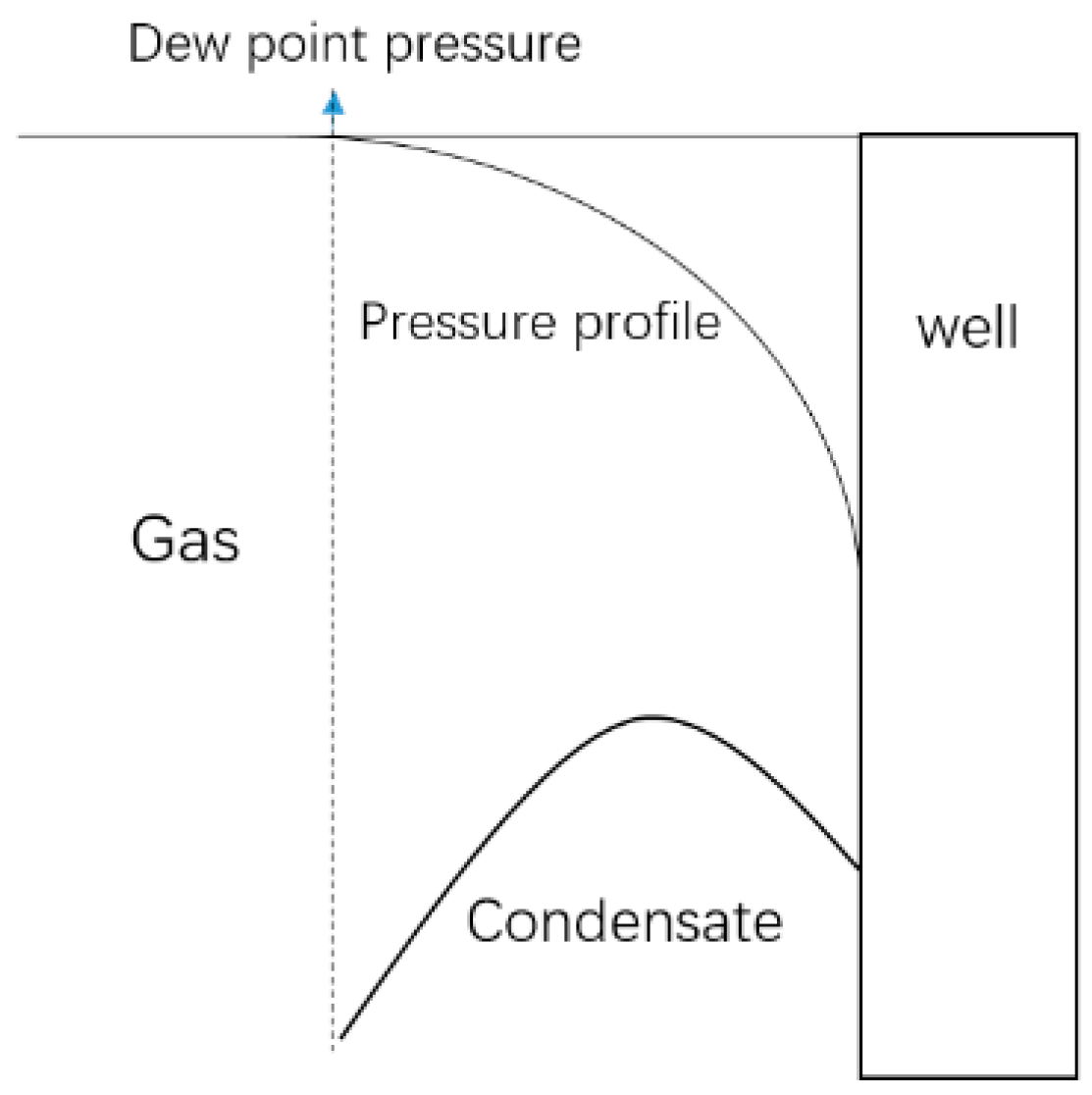



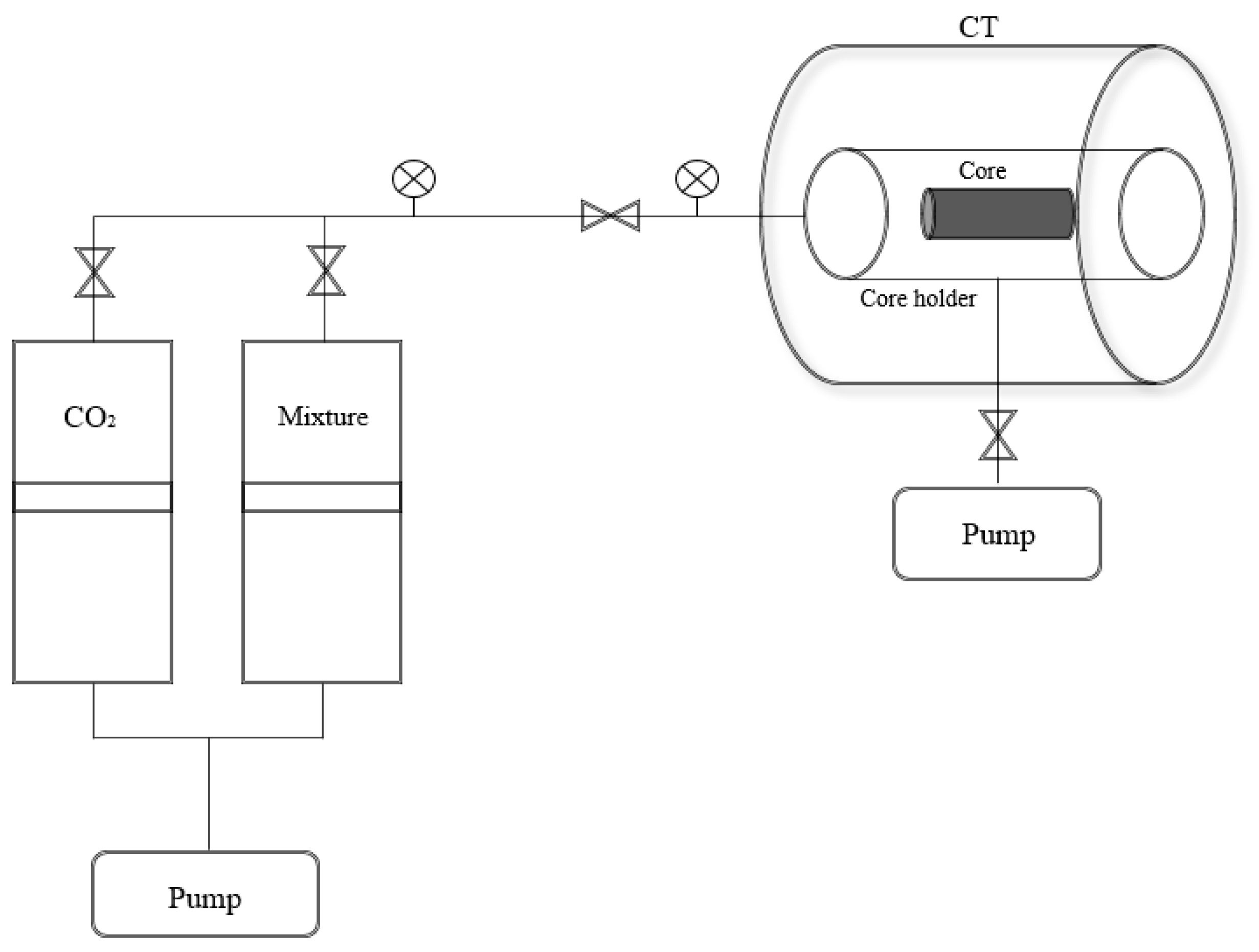
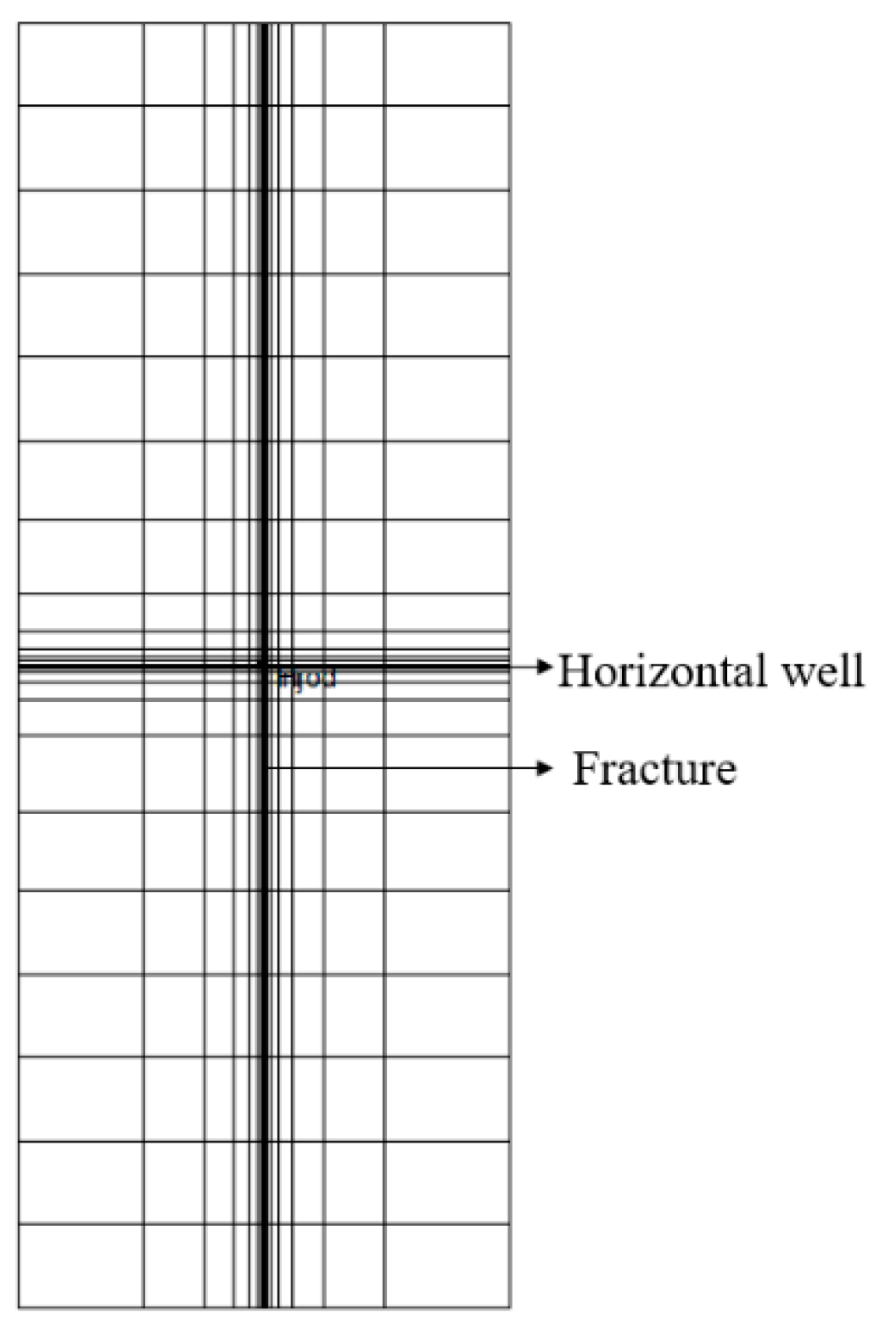
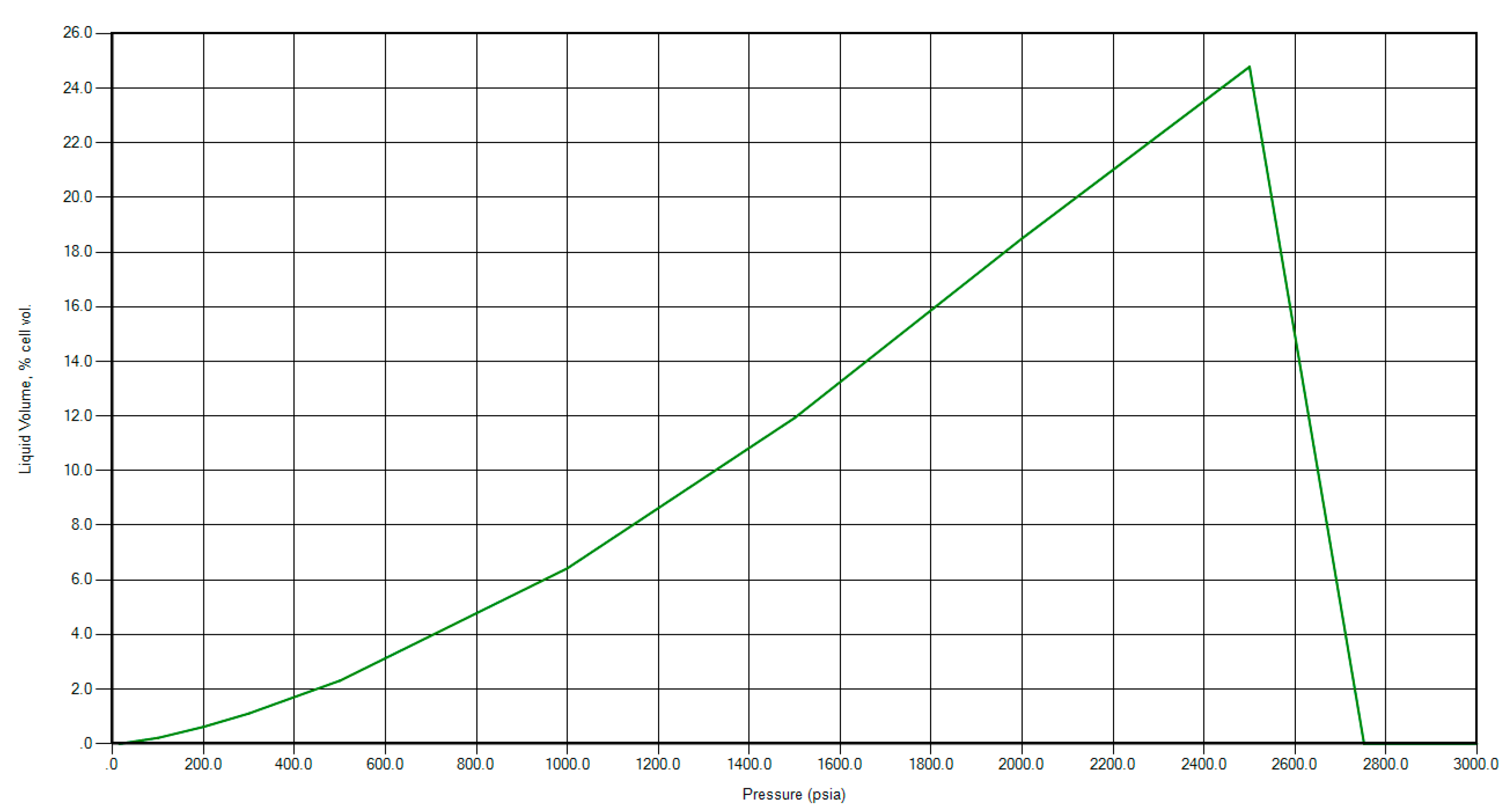
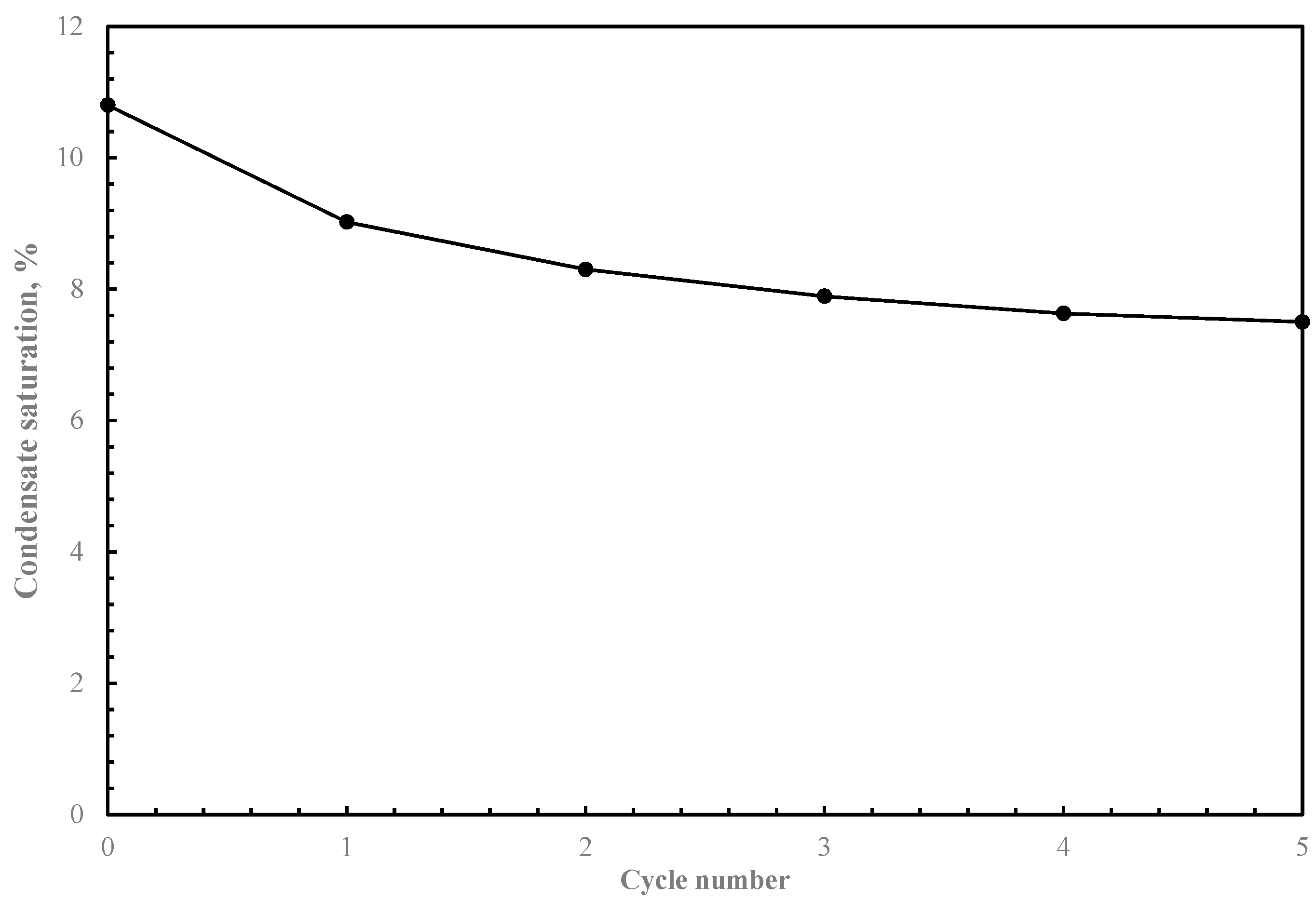

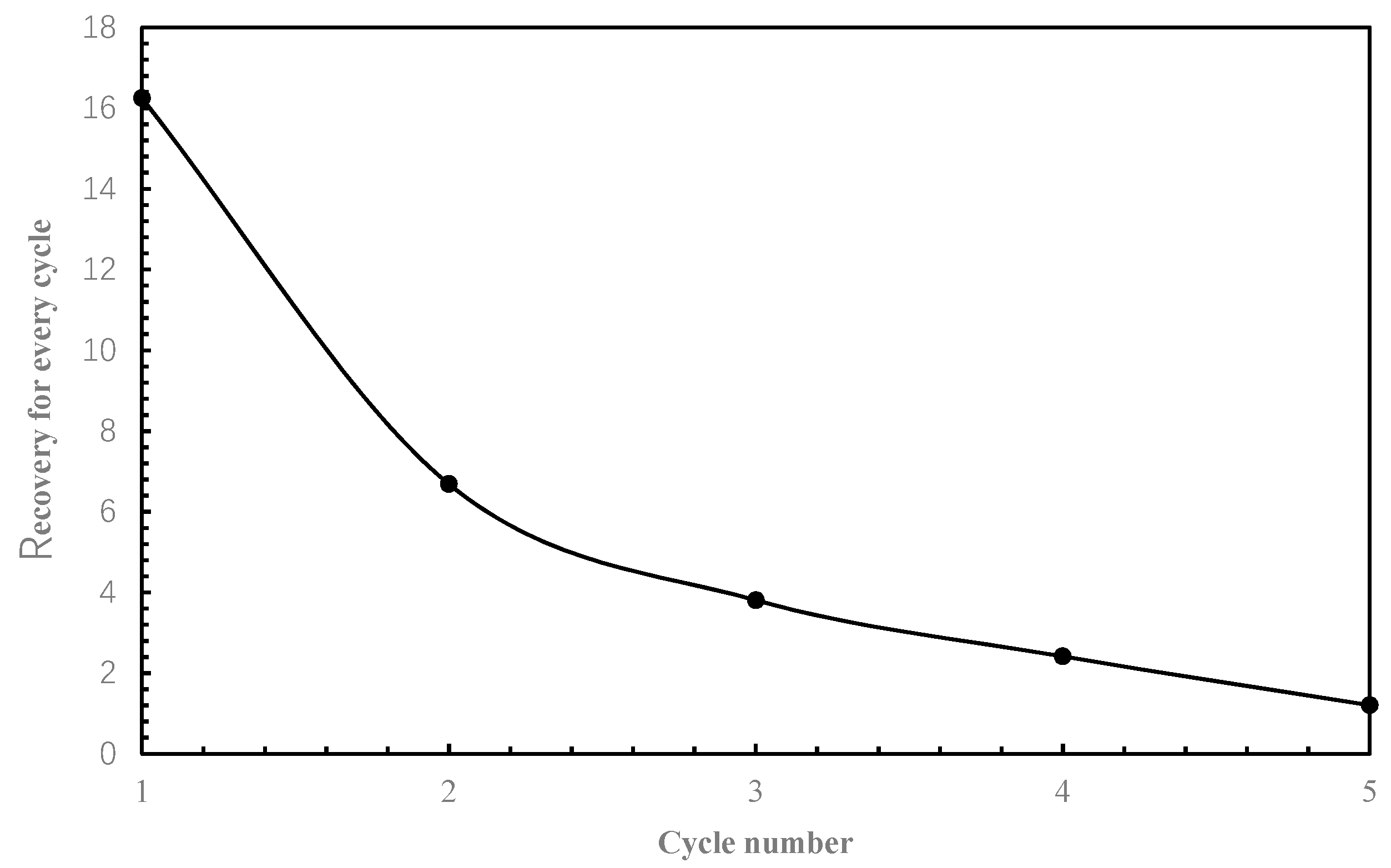
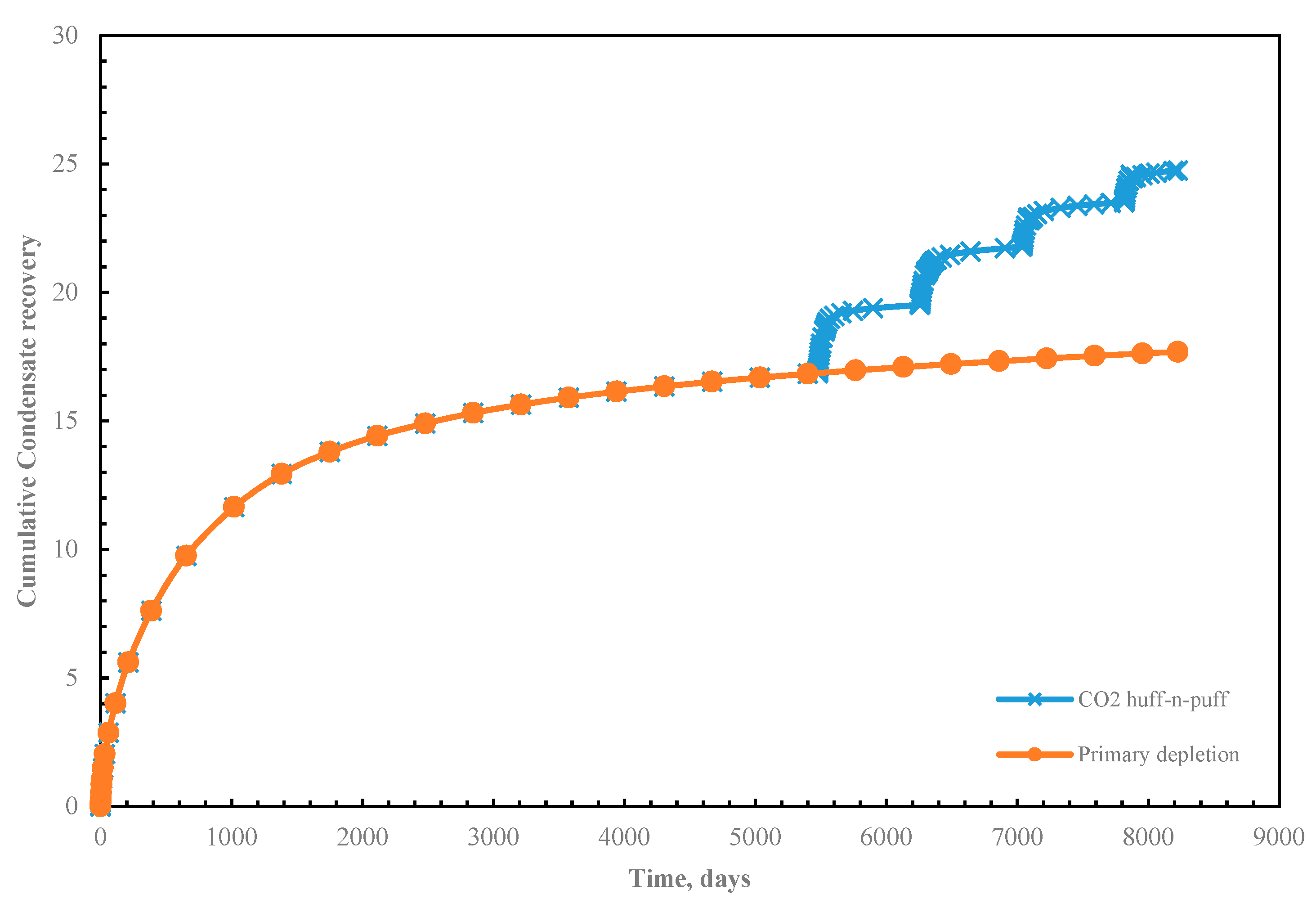
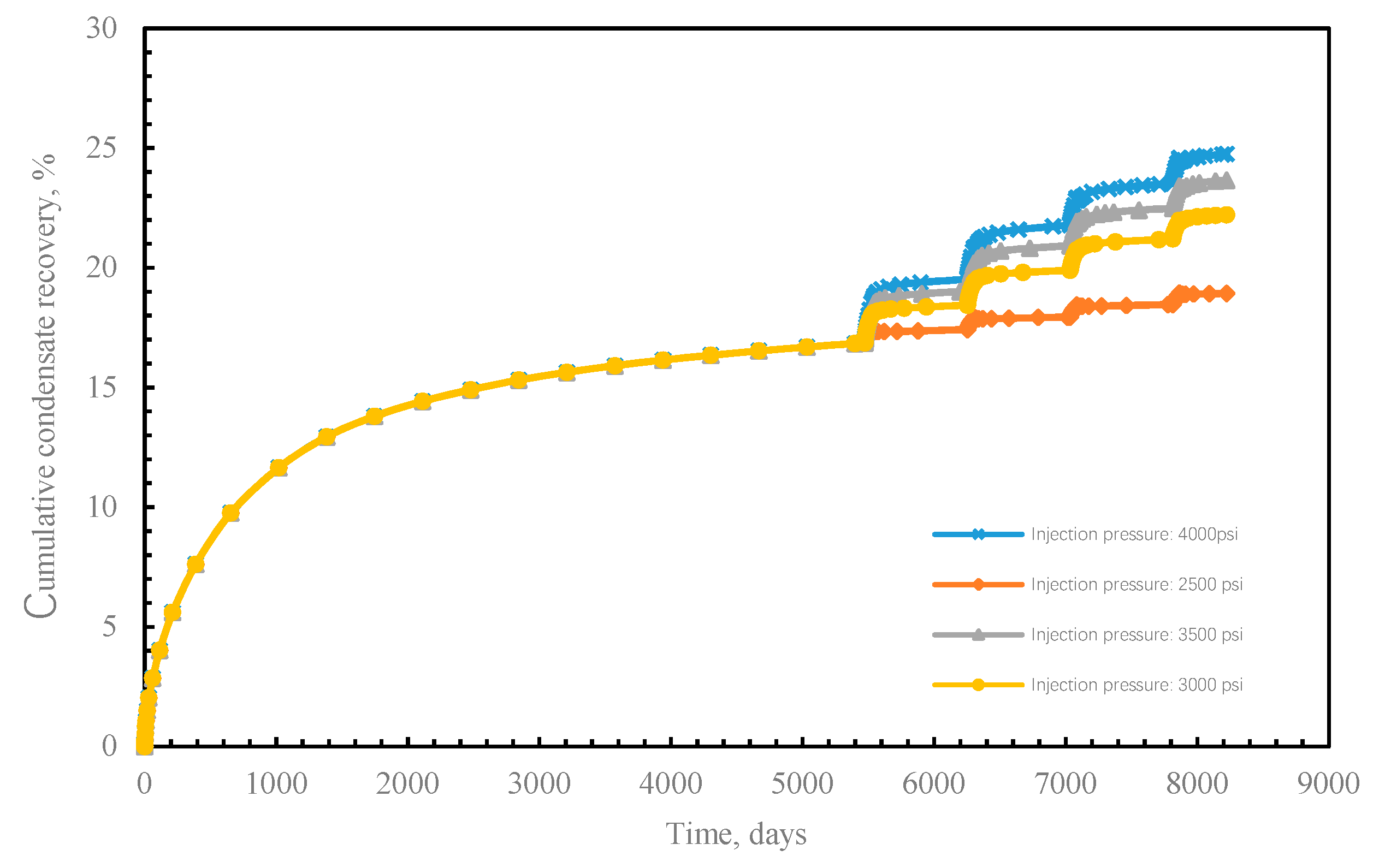
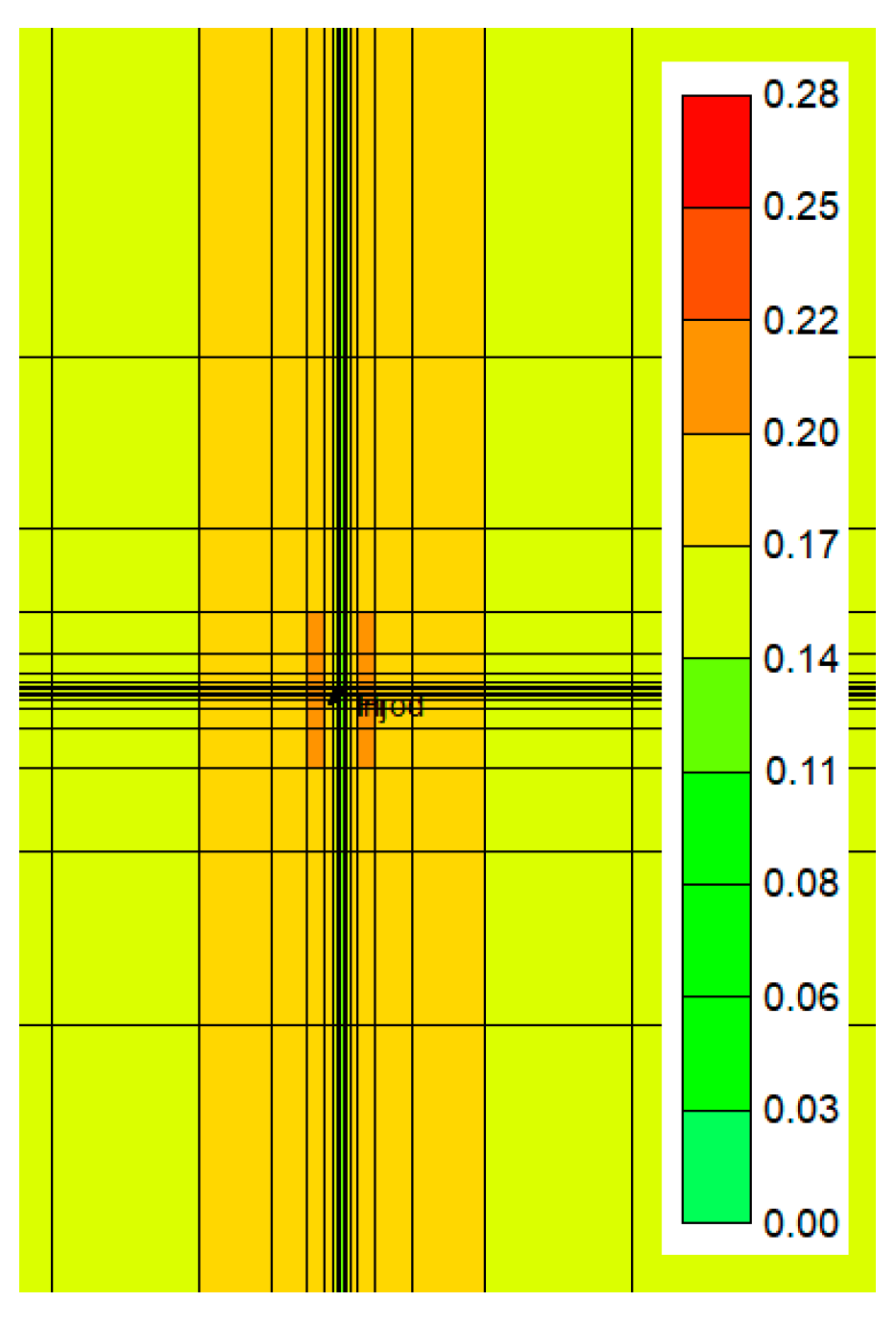


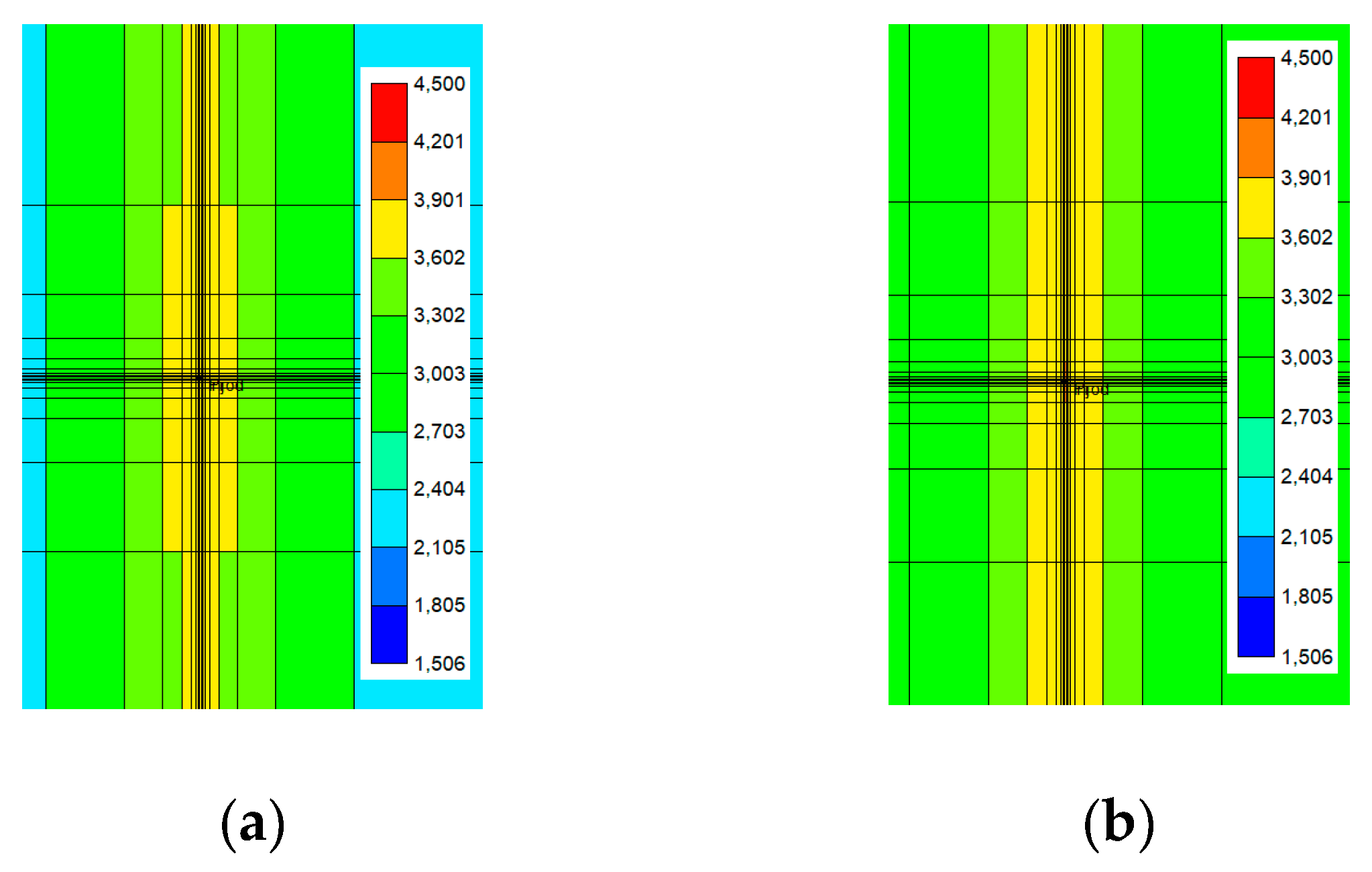
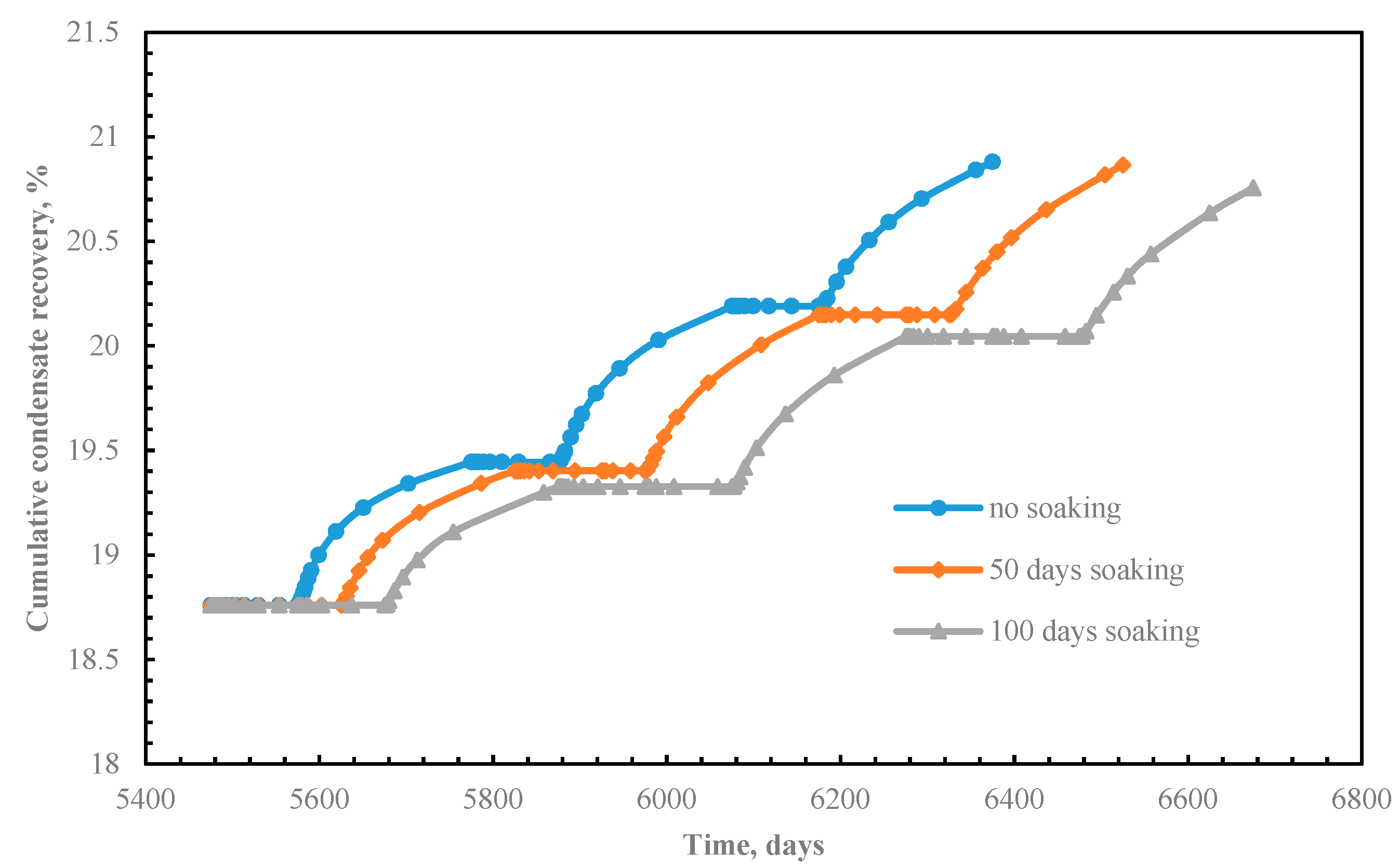

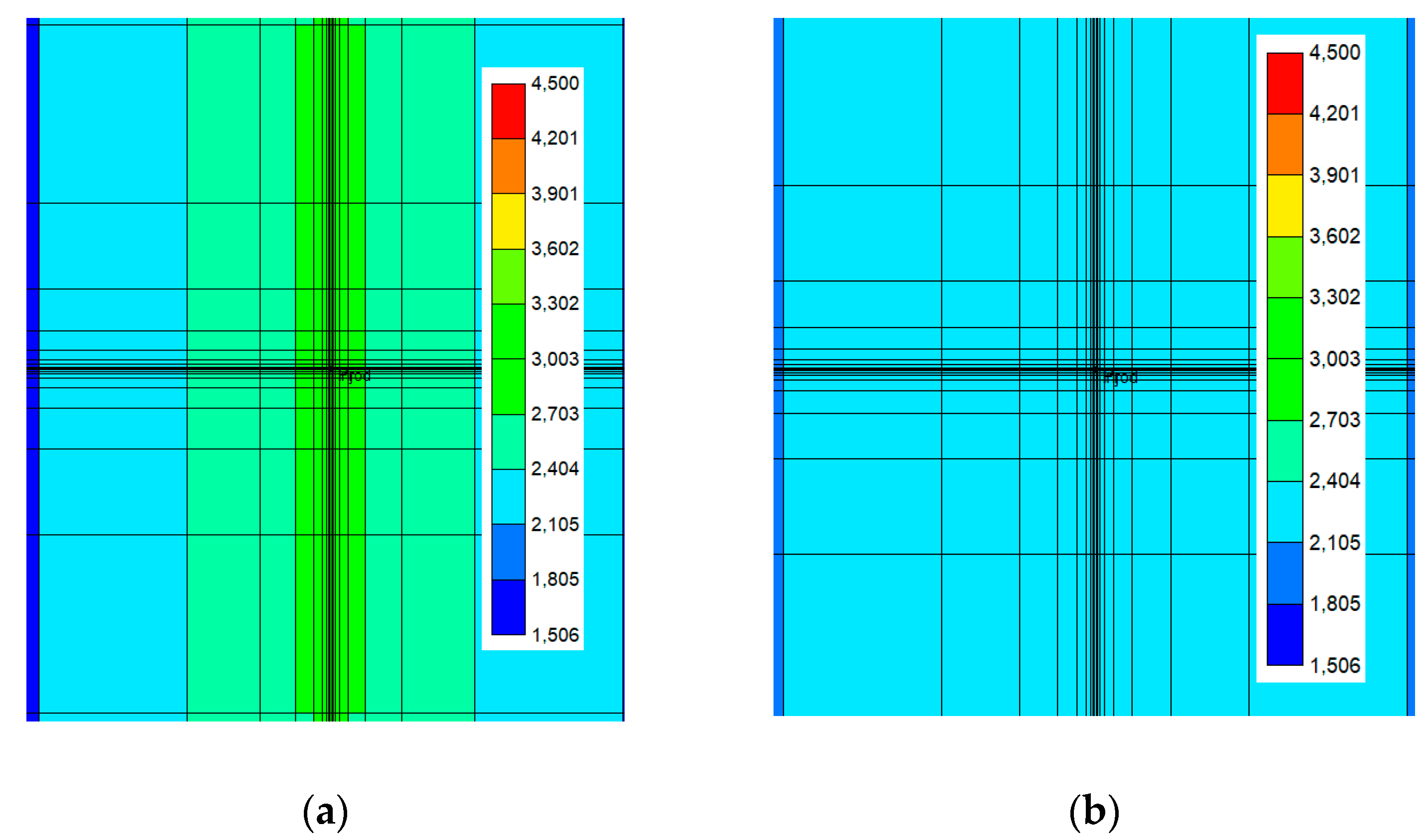
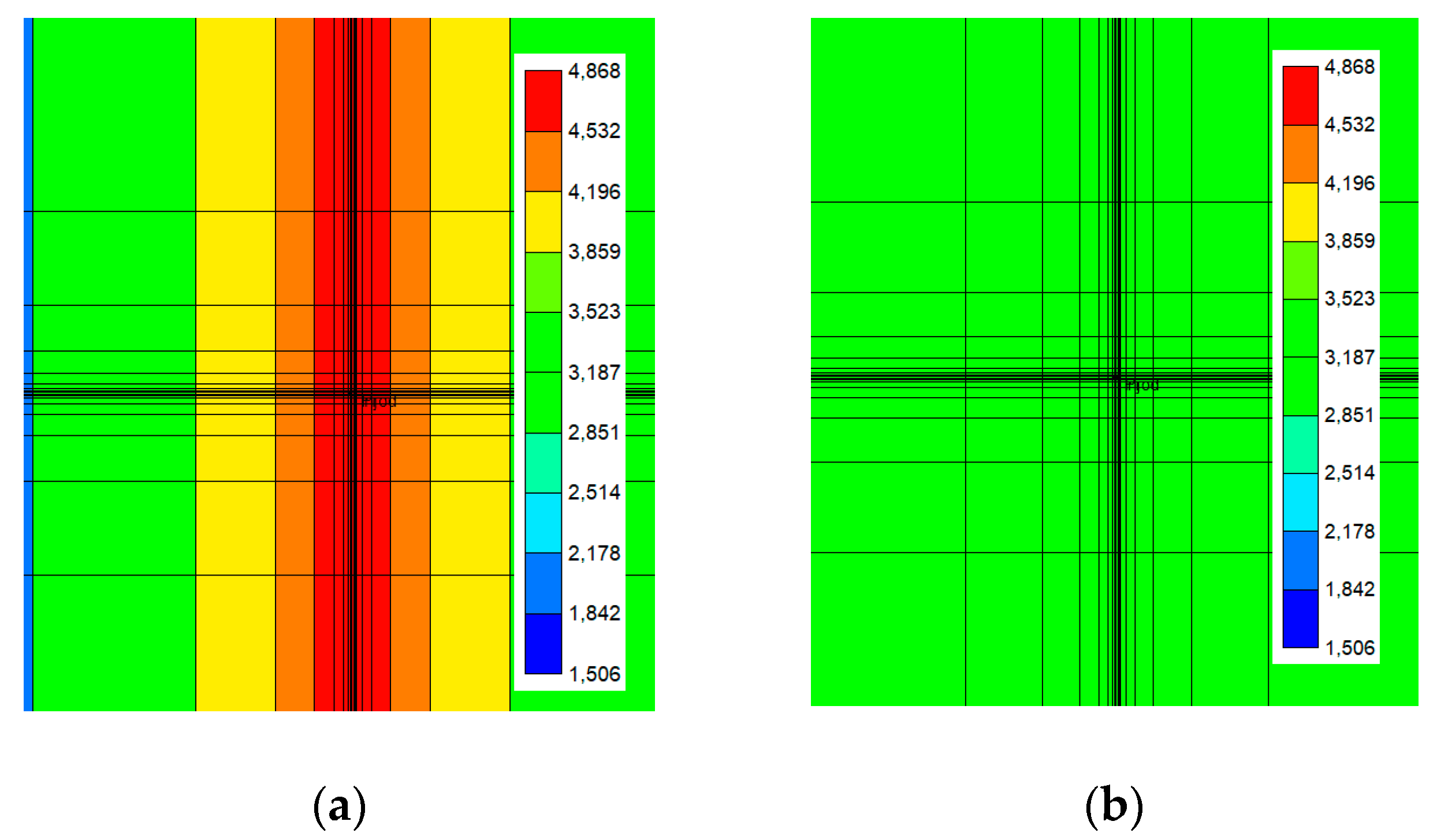
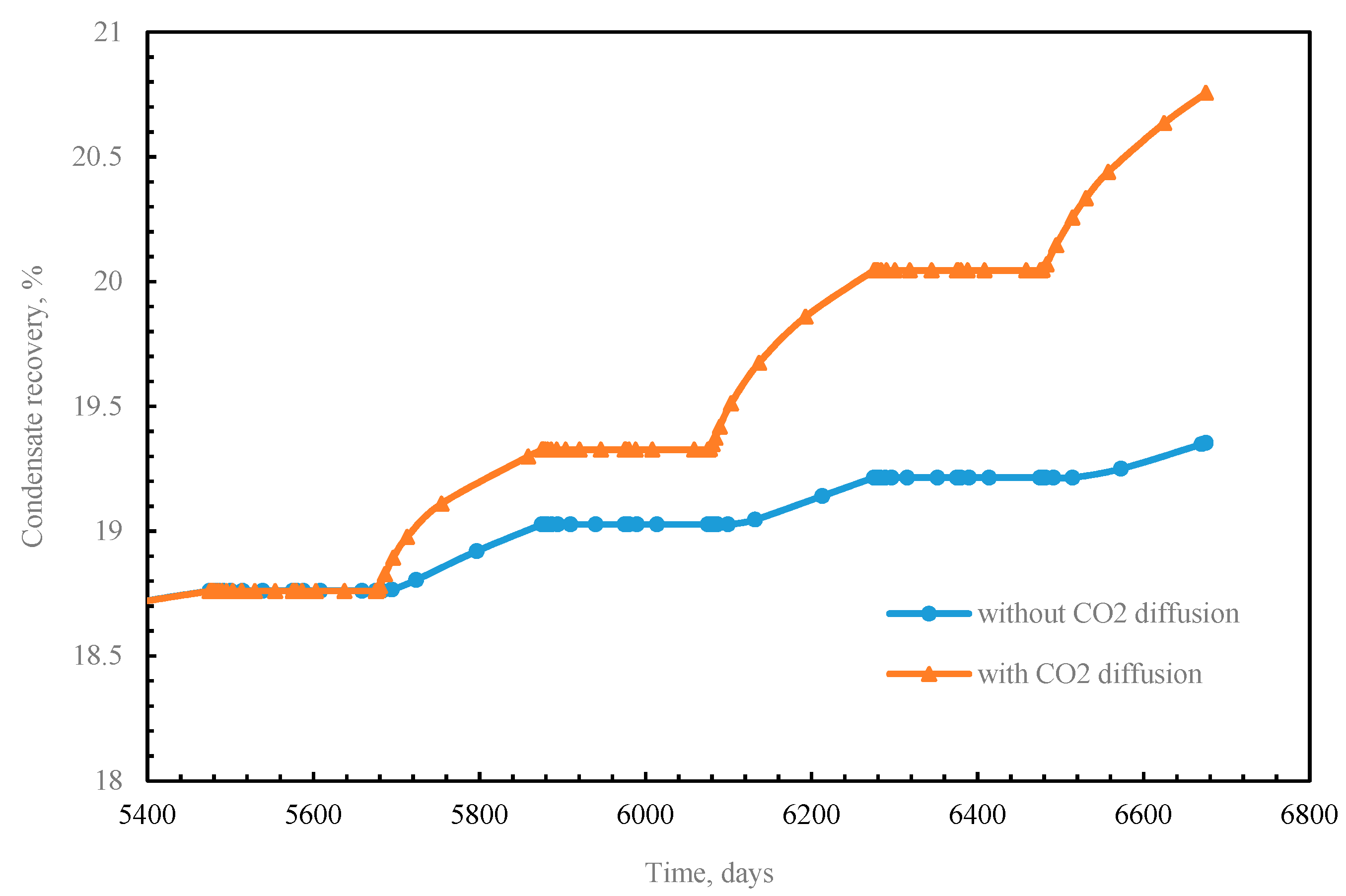
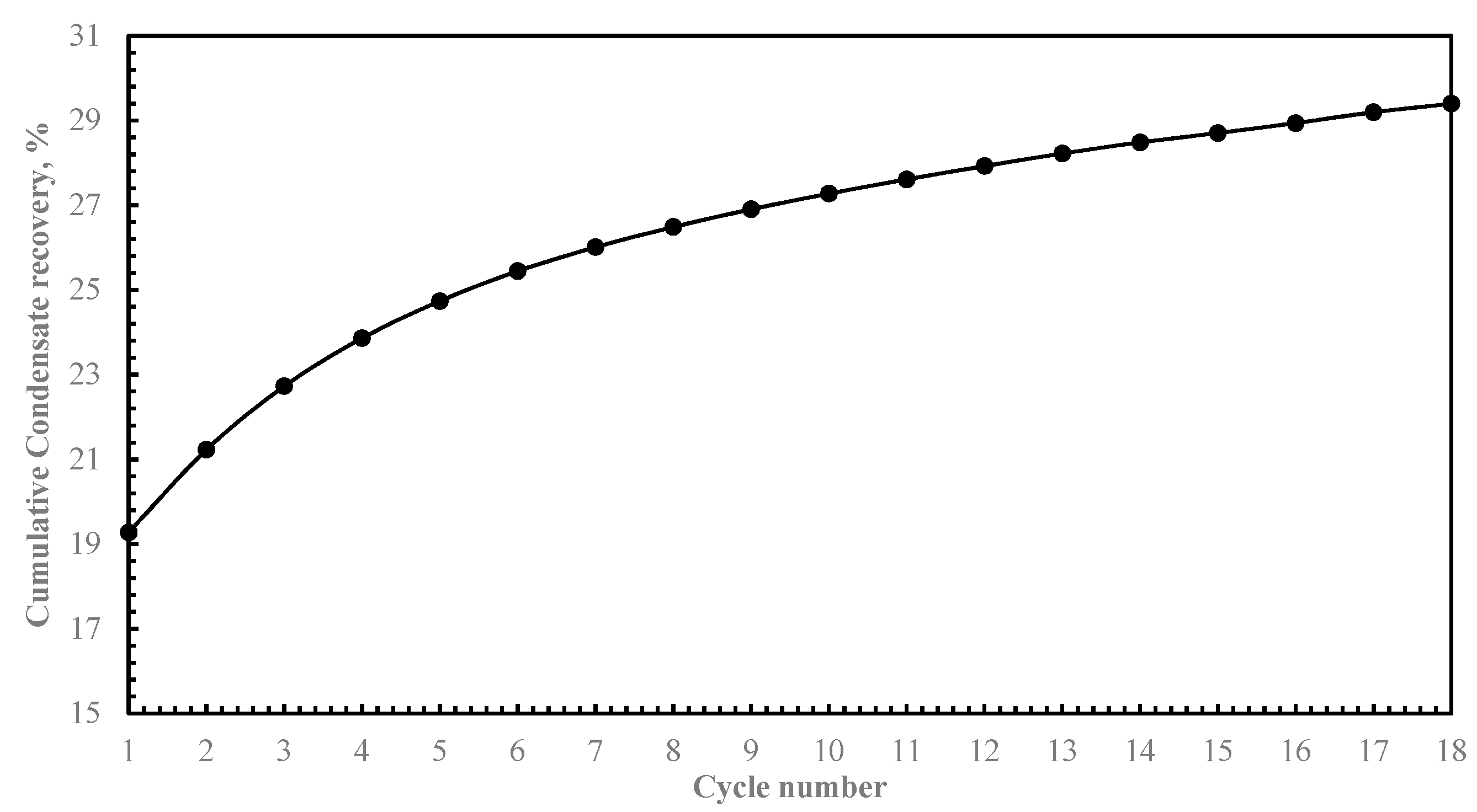
| Diameter (cm) | Length (cm) | Permeability (nD) | Porosity (%) |
|---|---|---|---|
| 3.8 | 10.2 | 100 | 6.8 |
| Parameters | Value | Unit |
|---|---|---|
| Initial Reservoir pressure | 5000 | psi |
| Initial Reservoir Temperature | 93.3 | °C |
| Matrix Permeability | 0.0001 | mD |
| Matrix Porosity | 0.06 | - |
| Fracture Permeability | 100 | mD |
| Name | Composition |
|---|---|
| CO2 | 0.18 |
| N2 | 0.13 |
| CH4 | 61.92 |
| C2H6 | 14.08 |
| C3H8 | 8.35 |
| IC4 | 0.97 |
| NC4 | 3.41 |
| IC5 | 0.84 |
| NC5 | 1.48 |
| NC6 | 1.79 |
| NC7 | 1.58 |
| NC8 | 1.22 |
| NC9 | 0.94 |
| C10+ | 3.11 |
| Scenario | Case 1 | Case 2 | Case 3 | Case 4 | Case 5 | Case 6 |
|---|---|---|---|---|---|---|
| Soaking time | 0 days | 50 days | 100 days | 0 days | 50 days | 100 days |
| Injection pressure | 3000 psi | 3000 psi | 3000 psi | 5000 psi | 5000 psi | 5000 psi |
© 2018 by the authors. Licensee MDPI, Basel, Switzerland. This article is an open access article distributed under the terms and conditions of the Creative Commons Attribution (CC BY) license (http://creativecommons.org/licenses/by/4.0/).
Share and Cite
Meng, X.; Meng, Z.; Ma, J.; Wang, T. Performance Evaluation of CO2 Huff-n-Puff Gas Injection in Shale Gas Condensate Reservoirs. Energies 2019, 12, 42. https://doi.org/10.3390/en12010042
Meng X, Meng Z, Ma J, Wang T. Performance Evaluation of CO2 Huff-n-Puff Gas Injection in Shale Gas Condensate Reservoirs. Energies. 2019; 12(1):42. https://doi.org/10.3390/en12010042
Chicago/Turabian StyleMeng, Xingbang, Zhan Meng, Jixiang Ma, and Tengfei Wang. 2019. "Performance Evaluation of CO2 Huff-n-Puff Gas Injection in Shale Gas Condensate Reservoirs" Energies 12, no. 1: 42. https://doi.org/10.3390/en12010042




